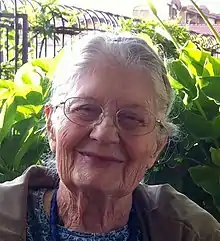Arianna W. Rosenbluth
Arianna Rosenbluth (September 15, 1927 – December 28, 2020) was an American physicist who contributed to the development of the Metropolis–Hastings algorithm. She wrote the first full implementation of the Markov chain Monte Carlo method.
Arianna W. Rosenbluth | |
|---|---|
 Rosenbluth in 2013 | |
| Born | Arianna Wright September 15, 1927 Houston, Texas, U.S. |
| Died | December 28, 2020 (aged 93) |
| Education | Lamar High School, Houston |
| Alma mater | Rice Institute Radcliffe College Harvard University |
| Known for | Metropolis algorithm |
| Spouse(s) | Marshall Rosenbluth (m. 1951 - div. 1978) |
| Scientific career | |
| Fields | Physics, computer science |
| Institutions | Stanford University Los Alamos National Laboratory |
| Doctoral advisor | John Hasbrouck Van Vleck |
Early life and education
Arianna Rosenbluth (née Wright) was born on September 15, 1927, in Houston, Texas.
She attended university at the Rice Institute, now Rice University, where she received a Bachelor of Science in 1946. In 1947 she obtained her Master of Arts from Radcliffe College[1] before beginning her PhD in physics at Harvard University under the supervision of Nobel Laureate John Hasbrouck Van Vleck. At the time Van Vleck also supervised the future Nobel Laureate Philip Warren Anderson and the philosopher of science Thomas Kuhn.[2] She completed her thesis, entitled Some Aspects of Paramagnetic Relaxation, in 1949 at the age of 22.[3]
Arianna was an accomplished fencer, winning not only the Texas women's championship in foil but also the Houston men's championship.[4] Her plans to complete in the Olympics were prevented first by the cancellation of the 1944 Summer Olympics and then inability to fund participation in the 1948 summer games.
Career
After completing her thesis Arianna won an Atomic Energy Commission postdoctoral fellowship to Stanford University which she attended before moving to a staff position at Los Alamos National Laboratory where her research focused on atomic bomb development and statistical mechanics.
Along with Marshall Rosenbluth she verified analytic calculations for the Ivy Mike test using the SEAC at the National Bureau of Standards.[5][6] Once the MANIAC I had been completed at Los Alamos she collaborated with Nicholas Metropolis, Marshall N. Rosenbluth, Augusta H. Teller, and Edward Teller to develop the first Markov chain Monte Carlo algorithm, in particular the prototypical Metropolis–Hastings algorithm, in the seminal paper Equation of State Calculations by Fast Computing Machines.[7] She developed the implementation of the algorithm for the MANIAC I hardware, making her the first person to ever implement the Markov chain Monte Carlo method.[5][6][8]
Over the next few years Arianna and Marshall applied the method to novel studies of statistical mechanical systems, including three-dimensional hard spheres and two-dimensional Lennard-Jones molecules and two and three-dimensional molecular chains.[9][10]
After the birth of her first child, Arianna left research to focus on raising her family.
Personal life
While at Stanford University she met Marshall Rosenbluth and the two married on January 26, 1951.[3] They had four children before divorcing in 1978.
In 1956 she moved from Los Alamos to San Diego, California and then Princeton, New Jersey, before finally settling in the greater Los Angeles area.
Death
Arianna died on December 28, 2020 in the greater Los Angeles, California area.
References
- "Harvard Physics PhD Theses, 1873–1953" (PDF). Archived from the original (PDF) on 2016-09-13. Retrieved 2017-06-27.
- "Philip W. Anderson – Session I". American Institute of Physics Oral History Interviews. Oral History Interviews.
- "University of Texas Marshall Nicholas Rosenbluth February 5, 1927–September 28, 2003". Archived from the original on 2017-08-12. Retrieved 27 June 2017.
- Holmes, Ann, "Whirling Arcs of Steel!" The Houston Chronicle, July 21, 1946.
- M.N. Rosenbluth (2003). "Genesis of the Monte Carlo Algorithm for Statistical Mechanics". AIP Conference Proceedings. 690: 22–30. doi:10.1063/1.1632112.
- "Marshall Rosenbluth - Session I". www.aip.org. 27 March 2015. Retrieved 31 December 2020.
- Metropolis, N.; Rosenbluth, A.W.; Rosenbluth, M.N.; Teller, A.H.; Teller, E. (1953). "Equation of State Calculations by Fast Computing Machines". Journal of Chemical Physics. 21 (6): 1087–1092. Bibcode:1953JChPh..21.1087M. doi:10.1063/1.1699114.
- Gubernatis, J. E. (2005). "Marshall Rosenbluth and the Metropolis algorithm". Physics of Plasmas. AIP Publishing. 12 (5): 057303. doi:10.1063/1.1887186. ISSN 1070-664X.
- Rosenbluth, Marshall; Rosenbluth, Arianna (1954). "Further Results on Monte Carlo Equations of State". The Journal of Chemical Physics. 22 (5): 881–884. Bibcode:1954JChPh..22..881R. doi:10.1063/1.1740207.
- Rosenbluth, Marshall; Rosenbluth, Arianna (1955). "Monte Carlo Calculation of the Average Extension of Molecular Chains". The Journal of Chemical Physics. 23 (2): 356–359. Bibcode:1955JChPh..23..356R. doi:10.1063/1.1741967.